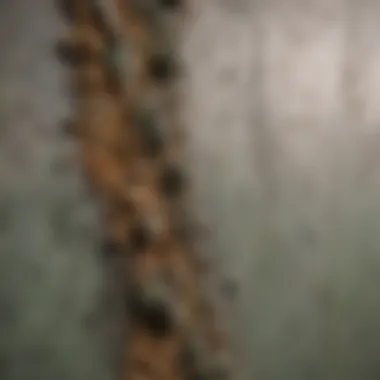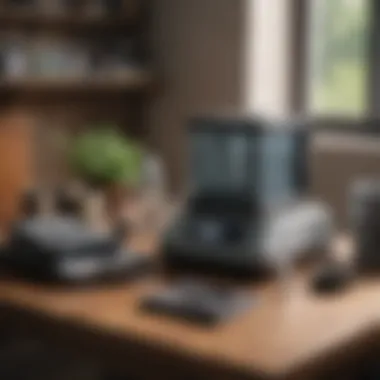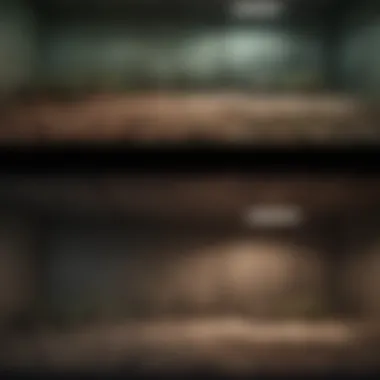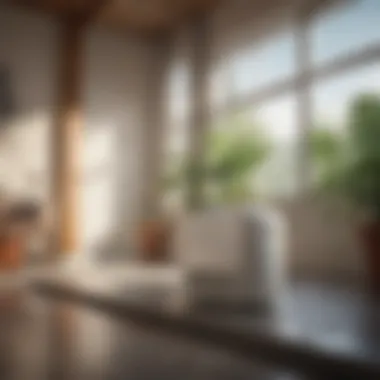Effective Mold Removal Techniques for Your Home


Intro
Mold is not just a nuisance; it poses significant health risks and can damage properties. Understanding how to effectively eliminate mold in indoor spaces is essential for homeowners and tenants alike. This guide aims to elucidate methods for mold removal, addressing not only methods to eradicate the problem but also preventative measures to deter future growth.
The key to managing mold lies in understanding its nature. Mold thrives in damp, warm environments, making certain areas of the home more susceptible, such as bathrooms, kitchens, and basements. Not only does mold compromise the appearance of your home, but it can also affect air quality, leading to respiratory issues and other health complications.
Having a comprehensive plan to tackle mold is critical. Various removal techniques exist, each with their strengths, and choosing the right one can depend on the severity of the mold growth and the specific conditions of the space.
In this guide, we will cover the foundational concepts behind mold growth, effective strategies for removal, the health risks associated with mold exposure, and long-term prevention tactics. This will help readers create a safer and healthier living environment.
Understanding Mold
Understanding mold is crucial for creating a safer living environment. Mold is more than just an eyesore; it can pose significant health risks and structural issues within homes. By grasping the basic principles of what mold is, the types that commonly invade indoor spaces, and the conditions that support its growth, homeowners can take proactive measures to fight against it. This section sets the foundation for the entire article by explaining these elements.
What is Mold?
Mold is a type of fungus that thrives in moist, warm environments. It reproduces through tiny spores, which spread easily in the air and can settle in damp areas. When mold spores land on a suitable surface, they grow and reproduce. Different species of mold can exist, each with distinct characteristics. In essence, mold is nature's recycler, breaking down organic matter, but when it invades homes, it can lead to unwanted consequences.
Types of Mold Commonly Found Indoors
In indoor environments, several mold types are frequently observed. The most common varieties include:
- Aspergillus: Often found in dust or damp places.
- Cladosporium: Typically grows on wood, textiles, and other porous surfaces.
- Stachybotrys chartarum: Also known as black mold, it is associated with water damage.
- Penicillium: Can grow on food and stored materials, often recognized by a blue or green color.
Understanding these molds helps target specific cleaning and prevention methods relevant to the type identified.
Conditions Favoring Mold Growth
Certain conditions create an ideal environment for mold proliferation. Common factors include:
- High Humidity Levels: Environments with humidity over 60% are favorable.
- Water Leaks: Leaking pipes or roofs provide moisture for mold.
- Poor Ventilation: Areas lacking air flow can trap humidity.
- Damp Materials: Items like carpets and drywall that remain wet can promote mold growth.
By identifying and addressing these conditions, one can reduce the chances of mold appearing in their living spaces.
Health Risks Associated with Mold
Mold is not just an aesthetic concern in homes; it poses a range of significant health risks. Understanding these risks is essential for homeowners, as it highlights the importance of swift mold remediation efforts. Mold exposure can lead to various health complications, depending on individual sensitivities and exposure levels. As mold spores spread through indoor air, they can trigger a variety of short-term and long-term health effects, which makes it crucial to identify, remove, and prevent mold growth in living spaces.
By being aware of the potential health effects, homeowners can better manage their living environments, increase awareness about mold-related issues, and promote healthier living conditions.
Short-Term Health Effects
Short-term exposure to mold can manifest in diverse symptoms, some of which may resemble common allergic reactions. Individuals might experience symptoms such as:
- Sneezing
- Coughing
- Nasal congestion
- Throat irritation
- Skin rashes
These symptoms can range from mild to severe, particularly in people who have existing allergies or respiratory conditions, such as asthma. Even individuals without any previous sensitivities may react to mold exposure if they encounter it in significant amounts.
It is important to note that some molds produce mycotoxins. These are toxic compounds that can exacerbate short-term health problems, making prompt removal of mold an essential action for ensuring a healthy home.
Long-Term Health Risks
Long-term exposure to mold can lead to more serious health issues that may affect various systems in the body. Individuals who spend extended periods in mold-infested environments may develop chronic respiratory problems, recurring sinus infections, or even more severe allergic reactions. Possible long-term health risks include:


- Chronic obstructive pulmonary disease (COPD)
- Asthma or worsening asthma symptoms
- Fungal infections in immune-compromised individuals
- Possible links to neurotoxicity and mental health issues in certain cases
The duration and intensity of exposure largely determine the severity of these effects. Homeowners should prioritize addressing any mold-related issues promptly to avoid potential long-term consequences that could arise from neglecting mold in their homes.
Identifying Mold Allergies and Sensitivities
Understanding how to identify mold allergies is a critical aspect of managing mold exposure. Some individuals may not immediately recognize their sensitivity to mold, as symptoms can start as subtle discomforts. Common signs of mold allergies include:
- Itchy or watery eyes
- Persistent cough
- Frequent nasal congestion
- Fatigue and general malaise
For those suspecting mold allergies, it is advisable to consult health professionals. Allergist testing may help determine specific sensitivities to mold types, enabling individuals to take appropriate actions in their living spaces.
Furthermore, maintaining a clean and dry environment can significantly reduce the risk of mold and its associated health complications. Therefore, understanding mold allergies and addressing them helps foster a healthier lifestyle for everyone in the household.
"Awareness of mold-related health risks can inspire timely actions, promoting immediate remediation to safeguard health."
Recognizing these health risks allows for better prevention and remediation strategies, ultimately creating safe and healthy indoor environments.
Identifying Mold Growth in a Room
Identifying mold growth in a room is a crucial step in maintaining a healthy indoor environment. Delaying mold detection can lead to health risks and structural damage to your property. Mold thrives in damp, poorly ventilated spaces. Recognizing the signs of its presence, even in hidden areas, can save homeowners from costly remediation efforts. Understanding how to effectively identify mold growth empowers individuals to take immediate action and restore a safe living space.
Visual Inspection Techniques
The first line of defense against mold growth is a thorough visual inspection. When searching for mold, pay attention to areas that are likely to harbor moisture. These include:
- Bathrooms: Look around sinks, tubs, and toilets.
- Kitchens: Check under sinks and behind appliances.
- Basements and attics: Inspect walls and ceilings for discoloration.
While inspecting, consider the following:
- Check for discoloration: Mold can appear as black, green, or white spots.
- Look for water stains: These are often signs of previous leaks, indicating a potential mold issue.
Utilize a flashlight to identify dark corners or hidden spots.
Uncovering Hidden Mold
Mold can also be hidden from plain sight. It is essential to adopt strategies to uncover these areas. Common places include:
- Behind drywall and wallpaper.
- Under carpets and rugs, particularly in high moisture areas.
- Inside ventilation ducts where condensation might occur.
To reveal hidden mold:
- Remove furniture: Checking behind and beneath items can expose unexpected growth.
- Gently pull back wallpaper: This could uncover hidden colonies that need attention.
In severe cases, consider employing moisture meters for more precision in locating damp spots where mold might thrive.
Assessing Musty Odors
A musty smell is often one of the first indicators of mold presence. It may seem slight at first but can intensify over time. If you detect an unpleasant odor, it is essential to investigate further. Follow these steps:
- Trace the source of the odor: Start in common mold-prone areas like kitchens or bathrooms.
- Consider recent changes in conditions: Has the room experienced increased humidity or water issues?
- Ask others about their experience: Sometimes, regular occupants may ignore odors.
Addressing a musty smell can provide clues to hidden mold.
Remember, early detection is vital, as mold can spread rapidly once established.


Overall, being diligent about checks and inspections can prevent significant problems down the line. Regular monitoring, coupled with the techniques above, will enhance your ability to identify and act on mold growth.
Effective Mold Removal Methods
Mold removal is a crucial aspect of maintaining a healthy indoor environment. Understanding effective methods not only facilitates the eradication of mold but also helps in preventing future growth. This section aims to provide clear strategies for cleaning mold from various surfaces, using both chemical solutions and natural alternatives. Each approach has its own advantages and considerations. Homeowners, interior design enthusiasts, and others need practical insights into these methods for a comprehensive understanding.
Cleaning Surfaces with Chemical Solutions
Using chemical solutions is often the most efficient way to remove mold from surfaces. Bleach, for instance, is commonly recommended because of its strong antibacterial properties. It’s effective on non-porous surfaces, such as tiles and bathtubs. However, caution must be taken; bleach should not be used on porous materials like wood or drywall, as it might only bleach the surface without penetrating deeply enough to kill the mold roots.
Key considerations include:
- Safety First: Always wear protective gear, including gloves and goggles, when handling strong chemicals.
- Follow Instructions: Each product has specific guidelines that must be adhered to for optimal results.
- Ventilation: Ensure proper ventilation in the area being treated to avoid inhaling harmful fumes.
Here are some common chemical cleaning products:
- Hydrogen Peroxide: An effective alternative to bleach, it can kill mold on various surfaces.
- Vinegar: While less effective on extensive mold outbreaks, it can still help on some surfaces.
- Commercial Mold Removers: Products like Mold Armor and Concrobium are specifically designed to tackle mold issues effectively.
Using Natural Mold Removal Alternatives
Natural alternatives for mold removal are gaining popularity due to their eco-friendliness and lower toxicity levels. Vinegar is one of the most used natural products; it effectively kills most types of mold. It does not emit harmful fumes, making it safer for indoor use. Baking soda combined with vinegar can create a powerful cleaning solution that also deodorizes surfaces.
Advantages of using natural solutions include:
- Low Toxicity: Much safer for use around children and pets.
- Cost-Effective: Common household products can be used instead of expensive chemical cleaners.
- Environmental Impact: Natural methods often have a smaller ecological footprint than chemical ones.
Consider these natural solutions for removing mold:
- Tea Tree Oil: A few drops mixed with water can create an effective mold-killing spray.
- Lemon Juice: The acidity helps to kill mold spores while leaving a fresh scent.
- Neem Oil: Known for its antifungal properties, it can be mixed with water for application.
Removing Moldy Materials
In some situations, the most effective way to eliminate mold from a room is by removing contaminated materials. This step is crucial when the mold has penetrated deeply into porous materials like drywall, carpeting, or upholstered furniture. Just cleaning the surface may not be enough, and in these cases, you have to consider replacement options.
Important points to consider before removal:
- Assessment of Damage: Determine the extent of mold damage to the materials in question.
- Disposal: Moldy materials must be sealed in plastic bags and disposed of carefully to prevent spore spread.
- Professional Help: If large areas are affected, consult a specialist for safe and efficient removal.
Materials often removed include:
- Drywall: If mold has spread beyond surface cleaning.
- Carpets and Rugs: Often retain moisture, becoming a breeding ground for mold.
- Insulation: Once moldy, insulation can be hard to dry and may need replacement.
"Thorough removal of moldy materials may be necessary to protect your health and your home."
Preventing Future Mold Growth
Preventing future mold growth is essential for maintaining a healthy indoor environment. Mold thrives in damp conditions and can develop in various locations if moisture is not effectively managed. By implementing proactive strategies, homeowners can significantly reduce the risks associated with mold and create a safer living space. Understanding and acting on these prevention techniques not only protects your home but also safeguards your health and well-being.
Controlling Humidity Levels
Humidity is a key factor in mold growth. Keeping humidity levels below 60% is crucial. Here are several methods to moisture control:
- Use Dehumidifiers: Dehumidifiers are effective in drawing excess moisture from the air. Place them in areas prone to dampness, such as basements or bathrooms.
- Monitor Humidity: Invest in a hygrometer to regularly check humidity levels in your home. This allows you to detect problems before they escalate.
- Proper Insulation: Insulating areas like attics and basements can reduce condensation, which helps to lower humidity. It is also important to check for leaks that might introduce moisture.
Ventilation and Air Circulation


Good ventilation is vital in preventing mold. Without it, moisture can become trapped, creating a favorable environment for mold. Consider these strategies:
- Open Windows: Whenever weather permits, open windows to enable fresh air circulation. This reduces humidity and helps to dissipate any moisture build-up.
- Use Exhaust Fans: Install exhaust fans in kitchens and bathrooms. These fans help expel humid air generated by cooking and showering, thus lowering indoor moisture levels.
- Ceiling Fans: Ceiling fans can circulate air throughout a room. Running these can contribute to better ventilation, especially in warmer months.
Regular Cleaning and Maintenance Practices
Establishing diligent cleaning routines is another effective way to prevent mold. Routine checks and maintenance can help detect any moisture issues before they become serious.
Here are some practices to consider:
- Frequent Cleaning: Clean regularly, especially in areas prone to moisture, like sinks and showers. Use anti-fungal cleaners to inhibit mold development.
- Address Water Leaks Promptly: Inspect plumbing for leaks and fix them immediately. Even minor leaks can contribute to mold growth over time.
- Declutter Spaces: Reducing clutter in your home allows for better air circulation. Mold often hides in forgotten items, so keeping spaces clear can help prevent unexpected outbreaks.
"Prevention is always better than cure. It is more effective to mitigate mold issues before they arise."
Committing to these preventative measures will not only diminish the likelihood of mold growth but also promote a healthier, more pleasant living environment.
When to Seek Professional Help
The issue of mold can become complex, inviting contemplation on when homeowners should consider professional assistance. Mold growth is not merely a cosmetic concern; it often signifies underlying issues that require expert evaluation and intervention. Understanding the factors that necessitate professional help can make a significant difference in managing mold risks effectively.
Identifying Large-Scale Infestations
Determining the scale of mold infestation is crucial. If mold covers an area larger than ten square feet, it's wise to consult professionals. Large-scale infestations can suggest extensive water damage or underlying issues within the structure itself.
To identify such infestations:
- Conduct a thorough inspection: Look in damp areas, such as basements, near plumbing, or under sinks.
- Use a flashlight: A bright light exposes areas that might seem dry but harbor mold.
- Note any water leaks: Fixes to these might only be temporary if mold growth is extensive.
Proper identification will guide homeowners on whether a serious problem exists. The larger the infestation, the greater the risk of damage to property and health.
Understanding Health Risks in Severe Cases
Severe mold cases pose substantial health risks, particularly for sensitive individuals. Mold spores can trigger allergies, respiratory issues, and other serious health conditions. In cases where symptoms worsen when indoors, professional help becomes more than advisable—it is essential.
Some health risks associated with extensive mold exposure include:
- Asthma attacks: Individuals with asthma may experience increased severity or frequency of their attacks.
- Chronic sinus issues: Mold can exacerbate sinusitis and chronic congestion.
- Immune system impact: Vulnerable individuals may face compromised immunity, making them more susceptible to infections.
"Mold exposure can lead to significant health consequences, emphasizing the need for timely intervention."
In instances of alarming symptoms or prolonged exposure, seeking professional mold remediation is not just a choice; it is a necessity for maintaining a safe living environment.
Being attuned to these indicators will equip homeowners with the knowledge to take action as needed. This way, one can not only remove the immediate threat but also safeguard their home's integrity and their health.
Epilogue
Understanding how to effectively deal with mold in indoor spaces is essential for maintaining both the aesthetic and health aspects of your living environment. Mold can pose significant health risks, as discussed earlier, and it thrives under specific conditions that can easily be found within homes. Therefore, recognizing the importance of each step in the mold removal process is crucial.
Summarizing Key Points
Throughout this guide, several key points have surfaced concerning mold management. We explored:
- What mold is: A biological organism that can reproduce quickly and cause health issues with its spores.
- Types of mold: Different varieties are prevalent indoors, such as black mold, which is often the most feared due to its toxicity.
- Health implications: Ranging from short-term respiratory issues to long-term chronic conditions, highlighting the necessity of prompt action upon identification.
- Identification methods: Visual inspections and attention to musty odors can aid in early detection.
- Removal techniques: Using either chemical solutions or natural alternatives offers flexibility based on environmental concerns or personal preferences.
- Prevention strategies: Emphasizing regular maintenance and humidity control can deter future mold growth.
Retaining these points in mind empowers homeowners and others involved in maintaining living spaces to take proactive measures against mold.
Final Recommendations for a Mold-Free Environment
Final recommendations for achieving a mold-free environment include:
- Control humidity: Keeping indoor humidity below 50% is essential. Use dehumidifiers where necessary.
- Ensure proper ventilation: Regularly ventilate spaces, especially high-moisture areas like bathrooms and kitchens.
- Conduct regular inspections: Make visual checks and smell checks part of routine cleaning tasks to catch any early signs of mold.
- Educate family members: Make sure that everyone is aware of mold hazards and understands the importance of prompt reporting of any mold sightings.
- Have a plan for severe cases: If mold infestations escalate beyond a manageable level, be prepared to consult professionals who specialize in mold remediation.
By implementing these recommendations, you can cultivate a healthier indoor environment, effectively reducing the risks associated with mold and cultivating a more pleasant home atmosphere.



